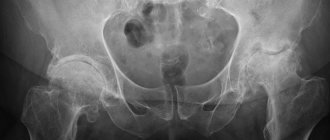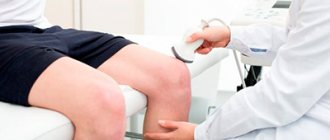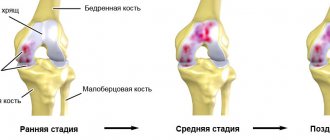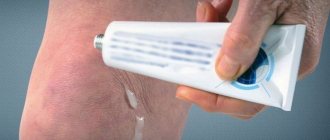Revision arthroplasty is a surgical intervention to remove the installed knee joint endoprosthesis and put a new one in its place. The operation is performed due to the instability of the implant. Revision interventions are performed in 8-10% of patients after primary surgery.
Renten after the initial operation. The implant is positioned correctly.
After installation of an oncological endoprosthesis, about 30% of patients require revision surgery. Organ-sparing treatment of tumors is more often accompanied by complications than conventional joint replacement.
Revision knee replacement surgery takes much longer than regular knee replacement surgery. This increases the risk of developing infectious, thromboembolic and other complications.
A removed endoprosthetic component due to wear.
The cost of repeated replacement, in the case of aseptic instability, it increases by 25-100%, and with the development of periprosthetic infection - by as much as 3-4 times. Prices for revision endoprostheses are also slightly higher than for regular ones.
In what cases is it necessary to replace the endoprosthesis?
Table 1. The most common complications requiring replacement of the endoprosthesis.
| Complication | Reasons for development | The essence and purpose of revision surgery |
| Periprosthetic infection | Microbial contamination of a wound during surgery or hematogenous introduction of bacteria from foci of infection in the body. | Clean the wound from necrotic masses, remove the components of the endoprosthesis, and carry out massive antibiotic therapy. Install a new endoprosthesis 3-6 months after the first stage of treatment. |
| Aseptic loosening | Incorrect selection and installation of endoprosthesis components or the development of osteolysis. | Removing a loose implant. Installation and reliable fixation of a new, revision endoprosthesis. Prescription of drugs that inhibit osteolysis. |
| Periprosthetic fracture | Installation of a large prosthesis, infection, osteoporosis, osteolysis. A fall or sudden movement can cause a fracture. | Carrying out metal osteosynthesis, if necessary, replacing individual components or the entire prosthesis. |
| Failure of muscles, ligaments, soft tissues | Unsuccessful surgical access to the knee joint during primary arthroplasty. | Carrying out revision surgery using a modified approach. |
| Damage to endoprosthesis components | Injuries, falls, dislocations, incorrect installation of the implant. | Replacement of damaged components of the endoprosthesis, their correct spatial orientation. |
| Relapse of the tumor | Incomplete removal or high grade of tumor. | Excision of the tumor. Selection and installation of an endoprosthesis that can completely restore bone tissue deficiency. |
Figure 2. Osteolysis (red arrow) around the tibia leads to loosening of the prosthesis (blue arrow).
When are revision surgeries indicated?
There are quite a few conditions that may require revision endoprosthetics. Below is an overview of the indications for revision surgery.
Dislocations in an artificial joint
| 01a. Dislocation in the hip joint endoprosthesis on an x-ray. | 01b. A rare observation is a dislocation in the knee joint endoprosthesis on an x-ray. |
Most often this concerns endoprostheses of the hip and shoulder joints. Regularly recurring dislocations make normal activity impossible and reduce the quality of life.
Causes
Disturbed position of the components of the endoprosthesis or, for example, the condition of periarticular tissues and formations - muscles, ligaments, tendons. Also, the reason may be a clear disregard for recommendations on the motor regimen or the inability to control movements in the operated joint (for example, due to a stroke).
Solutions
To eliminate the cause of systematically occurring dislocation, surgery is usually indicated. During its course, the disturbed position of the endoprosthesis components can be normalized, some of its elements can be replaced, and a special endoprosthesis (counteracting dislocation) can be installed.
| 01s. Endoprostheses of the hip joint with high resistance to dislocation. Left: “dual mobility” endoprosthesis - the small head “snaps” into a polymer insert, which, in turn, rotates freely in the bowl; Due to the large diameter, the likelihood of dislocation is minimal. Right: The head “snaps” into the liner, which “snaps” into the bowl. |
How to avoid?
- Choose a surgeon with sufficient experience.
- Before the operation, ask how high the risk of dislocations is in your case and what actions the surgeon intends to take to prevent dislocations?
- Start doing a set of exercise therapy exercises to strengthen your muscles in advance (you can download guidelines for the hip and knee joints).
Wear of friction unit materials in an artificial joint
02.Left: signs of wear on the x-ray - the heads are not located in the center of the artificial cavity; Right: worn polyethylene liner in the endoprosthesis cup. |
Causes
Any device in which friction occurs, especially under load, is subject to wear. When constructing joint endoprostheses, very durable materials are used in the friction unit, but wear still gradually occurs, especially when a metal/polyethylene friction pair is used.
You can read more about the wear resistance of endoprostheses here.
Solutions
Revision surgery is indicated to replace worn components. However, the operation is almost never limited to this - due to the reaction of tissues to wear products (particles of polyethylene, metal), it may be necessary to replace the entire endoprosthesis; at the same time, the resulting bone defects are replaced.
How to avoid?
- Discuss in advance with the surgeon the durability of the endoprosthesis being installed and the materials of the friction unit. You should choose (if possible) the most durable endoprosthesis.
- Trust the installation of the endoprosthesis to an experienced surgeon. Inaccurate installation increases the rate of wear.
- Do not subject the endoprosthesis to excessive loads, follow the recommendations of the operating surgeon.
Instability of the endoprosthesis (looseness)
03a. Loosening of endoprostheses on radiographs: zones of “clearing” around the endoprosthesis, migration and violation of the position of components are visible. On the left is a hip joint endoprosthesis; on the right - knee. |
Causes
Here we are talking about aseptic instability, that is, when loosening is not associated with the presence of infection in the area of the endoprosthesis. Sometimes the endoprosthesis loses its strong connection with the bone, and, as a rule, the likelihood of this phenomenon increases over the years. Most often, aseptic instability occurs as a result of exposure to wear products of the friction unit.
Solutions
Developed instability is an indication for revision endoprosthetics with the aim of installing another, most often a special revision one. Such endoprostheses provide the possibility of reconstructing lost tissue and, as a rule, have longer legs to ensure strong fixation in the remaining parts of the bone.
| 03b. Hip endoprostheses for primary (left) and revision (right) endoprosthetics. | ||
03c. Knee endoprostheses for primary (left) and revision (right) endoprosthetics. |
03d. Knee joint endoprostheses on radiographs: standard primary and revision. |
How to avoid?
Choosing a high-quality endoprosthesis with a durable friction pair will minimize the risk of developing aseptic instability. Don’t forget also the recommendations for point “2” (see above).
Infection of the endoprosthesis (deep periprosthetic infection)
04a. Left: microorganisms on the surface of the endoprosthesis under an electron microscope; Right: loosening of the knee joint endoprosthesis due to infection. |
Causes
Microorganisms can enter the endoprosthesis in various ways, for example, through the blood or lymph flow (hematogenous or lymphogenous infection) or, for example, as a result of medical procedures - injections, etc.
Direct infection of the endoprosthesis during surgery is very rare, since operations are performed under conditions of the strictest asepsis (its rules for orthopedic operations are the strictest).
Difficulties of treatment
If an infection develops in the area of the endoprosthesis (as well as in the area of any artificial device in the body - heart valve, vessel prosthesis, pacemaker), it is most often impossible to defeat it using conventional methods - prescribing antibiotics.
The fact is that, having settled on artificial organs, the infection becomes inaccessible to the action of antibiotics, other antimicrobial drugs and, most importantly, the immune system.
Solutions
If infection develops, surgical treatment is indicated. Under some favorable conditions, in the case of early development of infection, the operation of sanitation of a postoperative wound can have a good effect. However, in most cases more extensive surgery is indicated.
Revision operations for infection are among the most complex and are most often performed in several stages. At the first stage, the infected endoprosthesis is removed, the tissue is thoroughly cleaned of infection and a special device is installed - a spacer, which temporarily replaces the endoprosthesis and serves as a source of antibiotics included in its composition to destroy the infection.
04b.Spacers for temporary replacement of hip (left) and knee (right) joints. Spacers are made of bone cement (polymethyl methacrylate) with the addition of antibiotics. |
04c. Knee joint spacer on radiograph. |
In parallel, active long-term antibiotic therapy is carried out. After healing and in the absence of signs of recurrent infection, repeat arthroplasty can be performed. The shortest possible time between operations is 1.5 months.
How to avoid?
An important point in prevention is the sanitation of all inflammatory foci in the body before endoprosthetics. This should be taken extremely seriously. One of the requirements is always the sanitation of the oral cavity at the dentist’s appointment (a common occurrence is chronic foci of infection in the teeth).
It is also mandatory to take a course of antibacterial drug prophylaxis; for this purpose, a short course of antibiotics is prescribed during and after the operation.
The frequency of development of infectious complications is also influenced by the technique and duration of the operation, therefore, to perform it, you should choose a clinic in which joint replacement surgeries are performed regularly. The experience and competence of the surgical team also matters.
Bone fracture at the site of fixation of the endoprosthesis (periprosthetic fracture)
Causes
Unfortunately, no one is immune from injury, even people with artificial joints. Sometimes, as a result of a fracture, the endoprosthesis becomes unstable and requires replacement.
Solutions
Fractures can be of a wide variety. In some cases, it is permissible to perform osteosynthesis and leave the already installed endoprosthesis. In others, it is necessary to replace the endoprosthesis with a revision one with simultaneous restoration of bone integrity.
To ensure reliable fixation of the revision endoprosthesis in case of a complex fracture, bone reconstruction is performed during surgery. For this purpose, it is necessary to use rather complex devices (special plates, etc.), the cost of some of them is close to the cost of an endoprosthesis.
05a. Examples of periprosthetic fractures of the femur after arthroplasty of the hip joint and the results of revision arthroplasty. |
05b. An example of a periprosthetic fracture of the femur after knee replacement and the result of osteosynthesis with a pin. |
How to avoid?
There are no specific means of preventing periprosthetic fractures. However, careful behavior when wearing an artificial joint should always be preferred over activities with a high risk of injury.
REMEMBER: Treatment of a periprosthetic fracture can be significantly longer, more complex, and more expensive than treatment for a normal bone fracture.
Incorrect initial installation of the endoprosthesis
Manifestations are varied (dislocations, pain, impossibility of certain movements, leg length inequality) and strongly depend on which joint is prosthetized.
Sometimes the incorrect position of the endoprosthesis components does not manifest itself at all and only over time can lead to too early wear of the friction unit. In other cases, a periprosthetic fracture that occurred for no apparent reason may serve as an indicator of incorrect installation of the endoprosthesis.
Causes
Of course, inaccurate installation of the endoprosthesis is the result of a surgeon’s error, and we have to admit that such cases, although very rare, are observed even among highly qualified surgeons with very extensive experience. The likelihood of error can increase, for example, if the patient is very overweight.
Solutions
Reinstalling inaccurately located components is not always possible; after removing existing ones, you have to install new ones. Naturally, this affects the cost of treatment.
06. Incorrect installation of a knee joint endoprosthesis and the result of revision endoprosthetics. It was necessary to install a more massive and complex endoprosthesis. |
Removing stable endoprosthetic components can present significant technical challenges. Therefore, such operations are often quite lengthy.
How to avoid?
It is known that the more experience the operating surgical team has, the lower the likelihood of inaccurate installation of the endoprosthesis. Also important is the clinic’s equipment and the presence of competent rehabilitation specialists.
Breakage or destruction of endoprosthetic elements
Causes
Breakage may be a consequence of poor quality of the endoprosthesis, but sometimes we see breakdowns of even very high-quality endoprostheses. This can happen after many years of normal use (so-called stress fractures). In addition, breakage of the endoprosthesis may be the result of its incompletely correct installation. Due to the high quality of most modern endoprostheses, failures are very rare.
Occasionally, fractures of the ceramic heads of hip joint endoprostheses are observed as a result of serious trauma.
07. Fracture of the femoral stem of the hip joint endoprosthesis on an x-ray. |
Solutions
If the endoprosthesis breaks, it must be replaced. At the same time, operating surgeons sometimes have to deal with extremely difficult removal of broken fragments if they remain deep in the bone. Often, to completely remove all fragments, it is necessary to perform an osteotomy - additionally dissecting the bone with its subsequent restoration - osteosynthesis.
How to avoid?
The most important thing is not to skimp on the quality and correct selection of the endoprosthesis!
Allergic reactions to endoprosthesis
Despite the fact that all endoprostheses are made from materials with good biocompatibility, ions of metals such as Nickel, Cobalt, Chromium, Molybdenum, Tungsten, Manganese, Vanadium, Aluminum and, as a rare exception, Titanium can become allergens.
Materials such as ceramics or ultra-high molecular weight polyethylene, widely used in endoprosthetics, are not allergenic.
Solution path
In the event of a developed allergy to metal, the endoprosthesis is replaced with a special one made from completely non-allergenic materials or having a special surface structure that prevents free access of metal ions into the tissue fluid.
08. Examples of “hypoallergenic” endoprostheses. The “golden” coating of the endoprosthesis is the result of applying a special multilayer coating to the metal, the black color of the surface of the endoprosthesis on the right is a layer of zirconium oxide. |
How to avoid?
If you experience contact dermatitis when wearing metal objects (buckles, buttons, jewelry, etc.) or intolerance to metal dentures, you should definitely notify the operating orthopedic surgeon about this!
You are advised to use known non-allergenic endoprostheses.
Aseptic loosening
According to various authors, complication is the cause of 23-86% of revision surgical interventions.
Aseptic loosening develops as a result of osteolysis - non-inflammatory resorption of bone tissue near the implant. The cause may be systemic osteoporosis or age-related disorders of bone metabolism. Aseptic instability occurs due to improper implantation of endoprosthetic components.
The image shows the thinning zones of bone tissue.
Possible errors in the selection and installation of an implant:
- choosing the wrong prosthesis;
- incorrect selection of size, type and method of fixation of the implant;
- technical errors during the surgical procedure itself;
- inadequate spatial orientation of the endoprosthesis.
Aseptic instability can be early or late. The first develops over 5 years after surgery and usually indicates doctors’ mistakes. The second occurs at a later date, often due to bone resorption. There are a number of drugs that can help prevent osteolysis.
Knee replacement in the Czech Republic: guarantees, prices, rehabilitation, reviews and statistics.
Find out more
Methodology
The intervention is performed under general anesthesia. Tactics are determined taking into account the reason for repeated arthroplasty, the volume and nature of pathological changes. In case of instability of the implant and other conditions that are not accompanied by a pronounced deficiency of bone mass, the old prosthesis is removed, the conventional (primary) endoprosthesis is reinstalled, filling small defects with auto- or allograft bone or special cement. If there is significant loss of bone mass after removal of the old implant, bone alloplasty is performed, and then a hinged (revision) endoprosthesis is installed.
Infection - rejection
The pathology is characterized by inflammation of the bone tissue near the prosthesis with the subsequent development of septic instability of the joint. Complication ranks 2nd among all reasons for revision surgeries.
A red and hot seam is a reason to visit a doctor.
An absolute indication for repeat knee replacement is only late periprosthetic infection that develops later than 1 month after surgery. Earlier complications are treated conservatively or by surgical removal of some components of the prosthesis.
Knee spacers.
Revision endoprosthetics is most often carried out in two stages . Today, this approach is the “gold standard” in the treatment of infectious complications. One-stage reimplantation is possible only when the virulence of the pathogen is low and there are no systemic manifestations of infection. In this case, the patient should not have fistulas, massive bone defects, failure of soft tissues or capsular-ligamentous structures.
5. Cost
Quota
Some institutions have the opportunity to issue a quota for revision endoprosthetics and thus do not have to pay for treatment, however, the waiting period for hospitalization does not always fit within the optimal time frame for the operation, and the selection of implants available for use under quotas may not be sufficient to install the most suitable endoprosthesis — doctors have to improvise on the fly, trying to solve the problem with the means at their disposal.
However, there are other ways to perform the necessary endoprosthetic surgery.
Compulsory medical insurance
It is possible to contact the clinic of the Federal Bureau of Medical and Social Expertise with only a passport, compulsory medical insurance policy (of any region!) and the results of a preoperative examination. Moreover, all treatment (hospitalization, surgery, medications, rehabilitation), with the exception of implants necessary in some cases, are covered by the policy. Hospitalization at this clinic is also possible on a commercial basis.
Cost in a private clinic
The cost of revision surgery in a private clinic, as a rule, exceeds the cost of primary endoprosthetics surgery. A longer stay in the clinic, longer duration of the operation, and more expensive revision endoprostheses lead to an increase in price. The price of the latter can be two or more times higher than the price of regular ones.
However, in some cases their use is not required, and the complexity and duration of the operation is not so high. The cost of treatment in this case may be even less than with a conventional endoprosthetics operation. The cost of primary arthroplasty operations can be found in the relevant articles (see hip arthroplasty, knee arthroplasty, etc.).
A more accurate cost estimate can only be made in a face-to-face consultation with a specialist.
Damage to the implant
Among all damages to the endoprosthesis, wear of the tibial polyethylene liner is the most common. The problem can usually be resolved by open debridement. The essence of the operation is arthrotomy, surgical treatment of the articular cavity and replacement of the liner.
Result of injury or fall.
Revision arthroplasty should be done in case of repeated dislocations or fracture of one or more components of the prosthesis.
Contraindications to revision endoprosthetics
All contraindications to reoperation are divided into absolute and relative. If the former are present, surgical intervention is prohibited, as this can lead to serious complications.
Absolute contraindications:
- the patient's inability to move independently;
- hemiparesis on the side of the planned surgical intervention;
- acute or worsened thrombophlebitis;
- severe chronic diseases of the cardiovascular system;
- respiratory failure stage 3;
- the presence of unsanitized foci of chronic infection in the body;
- severe osteopenia;
- serious mental or neuromuscular disorders;
- absence of the medullary canal of the femur.
Relative contraindications include liver failure, severe chronic decompensated diseases, hormonal osteopathy and HIV-associated immunodeficiency conditions.
Examination before surgery
Before repeat joint replacement, the patient must undergo an examination. In addition to general clinical examinations, he is prescribed radiography of the knee joint in 2 projections, CT, MRI, densitometry and ultrasound examination of the veins of the lower extremities. The patient also undergoes a detailed coagulogram and echocardiography.
Tests, instrumental research methods and consultations with specialists help assess the general condition of the patient and the tactics of revision arthroplasty. This makes it possible to avoid unforeseen complications and make surgery successful.
When performing revision endoprosthetics, the correct selection of the implant is of great importance. Therefore, the hospital where surgery is performed must have a full line of endoprostheses available.
Possible complications
Despite the fact that at the preparatory stage doctors try to minimize all risks, in rare cases complications arise after surgery:
- Inflammation of the joint (infectious etiology).
- Insufficient stabilization of the knee implant, its loosening and wear.
- Dysfunction of the prosthesis.
The professional intervention of a surgeon will help solve the problem.
Knee replacement surgeries are performed by specialists from the Central Clinical Hospital of the Russian Academy of Sciences in Moscow. You can find out how much the operation costs, study patient reviews and step-by-step photos of the procedure on the clinic’s website. Call to schedule a consultation with specialists or receive any other information regarding the cost, preparation or implementation of knee replacement.
Surgery for infectious addition
Surgical intervention is most often performed in two stages, the interval between which can be from 3 to 6 months. At the first stage, surgeons remove the endoprosthesis and necrotic masses, treat the wound with antiseptics and install a cement spacer with broad-spectrum antibiotics. Only after the signs of infection disappear, the patient is fitted with a new endoprosthesis.
Curious! The surgical approach and the technique of layer-by-layer suturing of the wound usually differ in different clinics. In more “advanced” medical institutions, minimally invasive techniques are more often used, allowing surgical intervention to be performed with minimal harm to the patient.
Knee replacement surgery
On the eve of the operation, the patient is placed in a ward. For the entire duration of treatment, he is provided with all necessary hygiene items, as well as food. It is possible to place the patient with one of the relatives.
Immediately before prosthetics, the operating surgeon conducts a preoperative examination, the anesthesiologist selects the most optimal type of anesthesia, after which the patient is prepared for surgery.
The duration of the operation is from 1.5 to 3 hours. Depending on the indications, the operation is performed under spinal anesthesia or general anesthesia
Rehabilitation in the postoperative period
In the first days after surgery, the patient undergoes careful prevention of thromboembolic complications. For this purpose, his legs are bandaged with elastic bandages or stockings. At the same time, the patient is given a set of exercises to restore normal joint mobility. Note that in the first days, the medical staff practically teaches a person to move, walk, and climb stairs.
At first, the seam is securely hidden.
In the later recovery period, the patient needs therapeutic exercises, physiotherapy and some other rehabilitation measures. They help restore the functional activity of the knee and return the patient to a full life. The lack of full rehabilitation increases the risk of complications and often leads to unsatisfactory results of revision arthroplasty.








